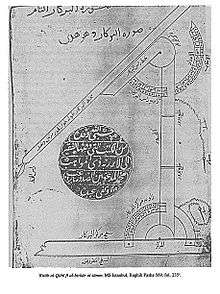Alī ibn Ahmad al-Nasawī
ʿAlī ibn Aḥmad al-Nasawī (c. 1010 possibly in Nasa, Khurasan – c. 1075 in Baghdad) was a Persian mathematician from Khurasan, Iran. He flourished under the Buwayhid sultan Majd al-dowleh, who died in 1029-30AD, and under his successor. He wrote a book on arithmetic in Persian, and then Arabic, entitled the "Satisfying (or Convincing) on Hindu Calculation" (al-muqni fi-l-hisab al Hindi). He also wrote on Archimedes's lemmata and Menelaus's theorem (Kitab al-ishba, or "satiation"). where he made corrections to The Lemmata as translated into Arabic by Thabit ibn Qurra, which was last revised by Nasir al-Din al-Tusi.
Al-Nasawī's arithmetic explains the division of fractions and the extraction of square and cubic roots (square root of 57,342; cubic root of 3, 652, 296) almost in the modern manner. Al-Nasawī replaces sexagesimal by decimal fractions.
Al-Nasawī's criticises earlier authors, but in many cases incorrectly. His work was not original, and he sometimes writes of matters that he does not understand, e.g. "borrowing" in subtraction.[1]
Ragep and Kennedy also give an analysis of a mid-12th-century manuscript in which a summary of Euclid's Elements exists by al-Nasawī.
Further reading
- Suter, H. Die Mathematiker und Astronomen der Araber (96, 1900) Uber das Rechenbuch des Ali ben Ahmed el-Nasawi (Bibliotheca Mathematica, vol. 7, 113-119, 1906).
- J. Ragep and E. S. Kennedy. A description of Zahiriyya (Damascus) MS 4871 : a philosophical and scientific collection, J. Hist. Arabic Sci. 5 (1-2) (1981), 85-108.
- Saidan, A. S. (1970–80). "Nasawī, ʿAlī Ibn Aḥmad al-". Dictionary of Scientific Biography. New York: Charles Scribner's Sons. ISBN 978-0-684-10114-9.
References
External links
- Yazdi, Hamid‐Reza Giahi (2007). "Nasawī: Abū al‐Ḥasan ʿAlī ibn Aḥmad al‐Nasawī". In Thomas Hockey; et al. The Biographical Encyclopedia of Astronomers. New York: Springer. pp. 820–1. ISBN 978-0-387-31022-0. (PDF version)
- Saidan, A. S. (2008) [1970-80]. "Al-Nasawī, Abu 'L-Ḥasan, 'Alī Ibn Aḥmad". Complete Dictionary of Scientific Biography. Encyclopedia.com.
